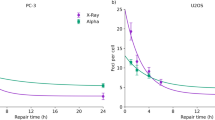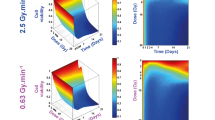Abstract
Radiation-induced bystander responses are observed when cells respond to their neighbours being irradiated. Considerable evidence is now available regarding the importance of these responses in cell and tissue models. Most studies have utilized two approaches where either a media-transferable factor has been assessed or cells have been exposed to low fluences of charged particles, where only a few percent are exposed. The development of microbeams has allowed nontargeted responses such as bystander effects to be more carefully analysed. As well as charged particle microbeams, X-ray microprobes have been developed, and several groups are also developing electron microbeams. Using the Gray Cancer Institute soft X-ray microprobe, it has been possible to follow the response of individual cells to targeted low doses of carbon-characteristic soft X-rays. Studies in human fibroblasts have shown evidence of a significant radiation quality-dependent bystander effect, measured as chromosomal damage in the form of micronuclei which is radiation quality dependent. Other studies show that even under conditions when only a single cell is targeted with soft X-rays, significant bystander-mediated cell killing is observed. The observation of bystander responses with low LET radiation suggests that these may be important in understanding radiation risk from background levels of radiation, where cells observe only single electron track traversals. Also, the indirect evidence for these responses in vivo indicates that they may have a role to play in current radiotherapy approaches and future novel strategies involving modulating nontargeted responses.
This is a preview of subscription content, access via your institution
Access options
Subscribe to this journal
Receive 50 print issues and online access
$259.00 per year
only $5.18 per issue
Buy this article
- Purchase on Springer Link
- Instant access to full article PDF
Prices may be subject to local taxes which are calculated during checkout




Similar content being viewed by others
References
Auclair C, Gouyette A, Levy A and Emerit I . (1990). Arch. Biochem. Biophys., 278, 238–244.
Azzam EI, de Toledo SM, Gooding T and Little JB. (1998). Radiat. Res., 150, 497–504.
Azzam EI, de Toledo SM and Little JB . (2001). Proc. Natl. Acad. Sci. USA, 98, 473–478.
Barcellos-Hoff MH and Brooks AL . (2001). Radiat. Res., 156, 618–627.
Belyakov OV, Folkard M, Mothersill C, Prise KM and Michael BD . (2002). Radiat. Prot. Dosim., 99, 249–251.
Belyakov OV, Malcolmson AM, Folkard M, Prise KM and Michael BD . (2001). Br. J. Cancer, 84, 674–679.
Belyakov OV, Prise KM, Trott KR and Michael BD . (1999). Int. J. Radiat. Biol., 75, 985–993.
Bishayee A, Hill HZ, Stein D, Rao DV and Howell RW . (2000). Radiat. Res., 155, 1–10.
Bishayee A, Rao DV and Howell RW . (1999). Radiat. Res., 152, 88–97.
Braby LA . (1992). Scanning Microsc., 6, 164–174.
Brenner DJ, Curtis RE, Hall EJ and Ron E . (2000). Cancer, 88, 398–406.
Camphausen K, Moses MA, Menard C, Sproul M, Beecken WD, Folkman J and O'Reilly MS . (2003). Cancer Res., 63, 1990–1993.
Denning C and Pitts JD . (1997). Hum. Gene Ther., 8, 1825–1835.
Emerit I . (1994). Free Radic. Biol. Med., 16, 99–109.
Emerit I, Garban F, Vassy J, Levy A, Filipe P and Freitas J . (1996). Proc. Natl. Acad. Sci. USA, 93, 12799–12804.
Emerit I, Khan SH and Esterbauer H . (1991). Free Radic. Biol. Med., 10, 371–377.
Engels H, Menzel HG, Pihet P and Wambersie A . (1999). Strahlenther Onkol., 175 (Suppl 2), 47–51.
Folkard M, Schettino G, Vojnovic B, Gilchrist S, Michette AG, Pfauntsch SJ, Prise KM and Michael BD . (2001). Radiat. Res., 156, 796–804.
Folkard M, Vojnovic B, Hollis KJ, Bowey AG, Watts SJ, Schettino G, Prise KM and Michael BD . (1997a). Int. J. Radiat Biol., 72, 387–395.
Folkard M, Vojnovic B, Prise KM, Bowey AG, Locke RJ, Schettino G and Michael BD . (1997b). Int. J. Radiat. Biol., 72, 375–385.
Hickman AW, Jaramillo RJ, Lechner JF and Johnson NF . (1994). Cancer Res., 54, 5797–5800.
Hollowell JG and Littlefield G . (1968). Proc. Soc. Exp. Biol. Med., 129, 240–244.
Iyer R and Lehnert BE . (2002). Mutat. Res., 503, 1–9.
Khan MA, Hill RP and Van Dyk J . (1998). Int. J. Radiat. Oncol. Biol. Phys., 40, 467–476.
Korystov Yu N, Shaposhnikova VV, Dobrovinskaya OR and Eidus L . (1993). Radiat. Res., 134, 301–306.
Lorimore SA, Coates PJ, Scobie GE, Milne G and Wright EG . (2001). Oncogene, 20, 7085–7095.
Lorimore SA, Kadhim MA, Pocock DA, Papworth D, Stevens DL, Goodhead DT and Wright EG . (1998). Proc. Natl. Acad. Sci., 95, 5730–5733.
Lyng FM, Seymour CB and Mothersill C . (2002). Radiat. Res., 157, 365–370.
McMasters RA, Saylors RL, Jones KE, Hendrix ME, Moyer MP and Drake RR . (1998). Hum. Gene Ther., 9, 2253–2261.
Mesnil M, Piccoli C, Tiraby G, Willecke K and Yamasaki H . (1996). Proc. Nat. Acad. Sci. USA, 93, 1831–1835.
Miller JH, Sowa Resat M, Metting NF, Wei K, Lynch DJ and Wilson WE . (2000). Radiat. Environ. Biophys., 39, 173–177.
Miller RC, Randers-Pehrson G, Geard CR, Hall EJ and Brenner DJ . (1999). Proc. Natl. Acad. Sci. USA, 96, 19–22.
Moiseenko VV, Battista JJ, Hill RP, Travis EL and Van Dyk J . (2000). Int. J. Radiat. Oncol. Biol. Phys., 48, 1539–1548.
Morgan GW and Breit SN . (1995). Int. J. Radiat. Oncol. Biol. Phys., 31, 361–369.
Morgan WF . (2003). Radiat. Res., 159, 567–580.
Mothersill C and Seymour C . (1997). Int. J. Radiat. Biol., 71, 421–427.
Mothersill C and Seymour CB . (1998). Radiat. Res., 149, 256–262.
Nagar S, Smith LE and Morgan WF . (2003). Cancer Res., 63, 324–328.
Nagasawa H and Little JB . (1992). Cancer Res., 52, 6394–6396.
Obedian E, Fischer DB and Haffty BG . (2000). J. Clin. Oncol., 18, 2406–2412.
Prise KM, Belyakov OV, Folkard M and Michael BD . (1998). Int. J. Radiat. Biol., 74, 793–798.
Prise KM, Folkard M, Malcolmson AM, Pullar CH, Schettino G, Bowey AG and Michael BD . (2000a). Adv. Space Res., 25, 2095–2101.
Prise KM, Folkard M and Michael BD . (2000b). Radiation Research, 2, Moriarty, M, Mothersill C, Seymour, C, Edington M, Ward JF and Fry RJM (eds). Allen Press: Lawrence, KS, pp. 174–177.
Ramesh R, Marrogi AJ, Munshi A, Abboud CN and Freeman SM . (1996). Exp. Hematol., 24, 829–838.
Randers-Pehrson G, Geard CR, Johnson G, Elliston CD and Brenner DJ . (2001). Radiat. Res., 156, 210–214.
Rothkamm K and Lobrich M . (2003). Proc. Natl. Acad. Sci. USA., 100, 5057–5062.
Schettino G, Folkard M, Prise KM, Vojnovic B, Bowey AG and Michael BD . (2001). Radiat. Res., 156, 526–534.
Schettino G, Folkard M, Prise KM, Vojnovic B and Michael BD . (2002). Radiat. Prot. Dosimetry, 99, 287–288.
Schettino G, Folkard M, Prise KM and Michael BD . In preparation.
Seymour CB and Mothersill C . (1997). Radiat. Oncol. Invest., 5, 106–110.
Shao C, Aoki M and Furusawa Y . (2001). J. Radiat. Res (Tokyo), 42, 305–316.
Shao C, Furusawa Y, Aoki M, Matsumoto H and Ando K . (2002). Int. J. Radiat. Biol., 78, 837–844.
Watson GE, Lorimore SA, Macdonald DA and Wright EG . (2000). Cancer. Res., 60, 5608–5611.
Wilson WE, Lynch DJ, Wei K and Braby LA . (2001). Radiat. Res., 155, 89–94.
Xue LY, Butler NJ, Makrigiorgos GM, Adelstein SJ and Kassis AI . (2002). Proc. Natl. Acad. Sci. USA, 99, 13765–13770.
Acknowledgements
We are grateful to our colleagues, Drs Giuseppe Schettino, Heidi Newman and Oleg Belyakov, who have undertaken our experimental studies on bystander responses, and the input of Professor Boris Vojnovic and his team in the development of our microbeam sources. They acknowledge Cancer Research UK (C1513/A2676), the European Commission (FIGH-CT1999-00003 FIGH-CT1999-00012), the UK Department of Health (RRX92) and the US Department of Energy (DE-FG02-02ER63305, DE-FG02-01ER63236, DE-FG07-99ER62877) for supporting their studies on radiation-induced bystander responses.
Author information
Authors and Affiliations
Corresponding author
Rights and permissions
About this article
Cite this article
Prise, K., Folkard, M. & Michael, B. Bystander responses induced by low LET radiation. Oncogene 22, 7043–7049 (2003). https://doi.org/10.1038/sj.onc.1206991
Published:
Issue Date:
DOI: https://doi.org/10.1038/sj.onc.1206991
Keywords
This article is cited by
-
Fractionated irradiation of right thorax induces abscopal damage on testes leading to decline in fertility
Scientific Reports (2019)
-
Non-uniform radiation-induced biological responses at the tissue level involved in the health risk of environmental radiation: a radiobiological hypothesis
Environmental Health (2018)
-
Non-targeted transcriptomic effects upon thyroid irradiation: similarity between in-field and out-of-field responses varies with tissue type
Scientific Reports (2016)
-
Use of the individual data of the a-bomb survivors for biologically based cancer models
Radiation and Environmental Biophysics (2010)
-
Influence of the bystander phenomenon on the chromosome aberration pattern in human lymphocytes induced by in vitro α-particle exposure
Radiation and Environmental Biophysics (2009)



